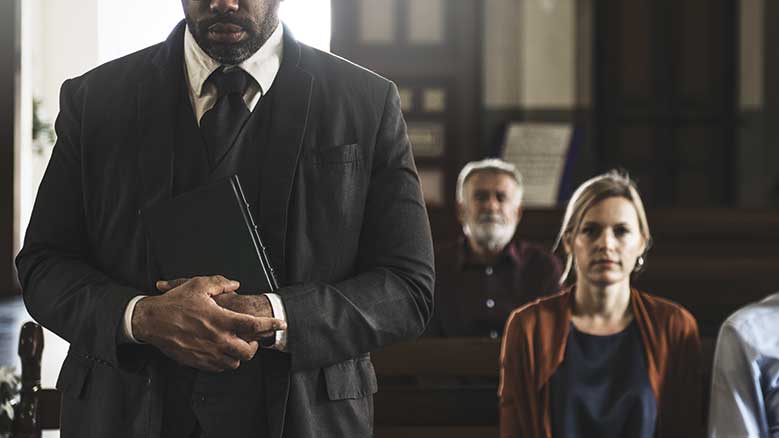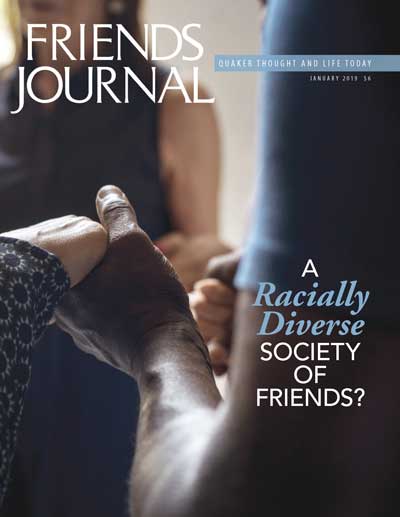
There seems to be an incongruence with the footprint of the church and the everyday needs of people. The Pew Research Center notes that San Francisco has the highest unchurched population for any metropolitan area in the United States: 45 percent of the adult population does not attend regular faith services. Taking a wider view, the largest Protestant denomination in the United States—the Southern Baptist Convention—continues to experience a hemorrhage of members. Evangelicals are organized because they have laid the groundwork for decades. What about primitive Christianity revived? It is my sense that Friends are exhausting ourselves with concern for political matters while the Quaker movement has nearly stalled.
Recently, when a well-known Friend heard that San Francisco (Calif.) Meeting has hosted a nonviolent self-defense training since January 20, 2017 (Inauguration Day), he seemed surprised. “I thought that movement was dead!” he declared. “Talitha cumi“—the remark of Christ in Mark 5 to bring back to life that which seems dead—rings in my heart. Let us breathe new life into our dry bones much like the extraordinary vision of an Old Testament refugee named Ezekiel.
Our lack of demographic diversity—and structural imagination—is painfully attested to by the statistics reported at Pacific Yearly Meeting’s (PYM) latest annual session. Not a single youth was added as a member in any of our 50 monthly meetings and worship groups. In the nineteenth century, yearly meetings had members numbering in the tens of thousands. Today, California is the most populous state in the union, yet our membership relegates us to near historical extinction. At this time of upheaval, are we not called to leave the comfort of the boat to step out onto the water in bold faith?
Our attempt at modernist theological diversity causes palpable strain. Many Friends in PYM no longer consider the Bible a source for spiritual edification. The Protestant principle of sola scriptura applies the light of restoration to all biblical exegesis. Friends who feel spiritually and politically abandoned participate in the misery that fuels the Christian encounter of African Americans. Recall the “God damn America” sermon by Rev. Jeremiah Wright? Without early Friends’ biblical imagery, we have little basis for discussing what was considered absolutely necessary for Christians and written about in dreadfully clear language: the day of visitation. This is the inner burning-away, the transformation, the resurrection to abundant life that so many I meet when street preaching are seeking.
Currently, our basic committee structures suffer due to our weakening membership. Where once only members served on committees, we now allow everyone. This is an example of a local-level change in our ecclesial structure caused by lack of capacity. It is spectacularly naive to pretend that the number of members doesn’t matter: it affects the work of every local nominating committee and therefore the lifecycle of our faith tradition.
Meeting for worship (and monthly concern for business) is the basic ingredient. This says nothing, however, of the distinct liturgical elements within this worship. Our lack of capacity, shrunken member rolls, and lack of clarity as to what the peace testimony means for neighborhoods patrolled by domestic, not foreign, instruments of state (e.g. police) stymies much of our potential blossoming. Our locally based structure allows for called meetings for worship with Methodists, Baptists, and others; rhythmic and swinging music-led worship groups; healing worship; and worships led by Spanish speakers and Friends of color. What one meeting feels called to (e.g. recorded ministry) need not be an exact replica of the practices of a meeting 40 miles away. If our focus is on the inward essence rather than the form, why do we insist on exact copies within the yearly meeting?
If all of the gifts of the Spirit are still available today, why aren’t they present among us?
My grumbling heart holds a worry that Friends have lost not our spirit but our willingness to be countercultural. Apart from the no-longer-culturally-relevant “thee” and “thou,” how do we stand out? In Christianity, the countercultural element is often expressed in “separatist” movements (e.g. stylite monks, Hutterites, Mennonites, cloistered Catholics). Quakerism, like wider Protestantism, has no ascetic “rump:” there is no day-to-day way of escaping the insidious web of money accumulation. Earlier in our history, meeting for worship was a financial, social, and spiritual center; this function has nearly been totally eliminated. Can there be a Quaker-specific form of the Catholic Worker, a peace revival?
As a Christian anarchist, I shamelessly imagine endless possibilities of the human spirit. With self-reflection and education, we can work alongside God for greater restoration. We are each challenged to listen for the Word of God within our hearts and respond faithfully. The challenge is that even this is subsumed by other cares and worries: Americans don’t have (and don’t demand) the leisure time needed for reflection and joint discernment.
George Fox worked to extirpate the outward (e.g. state-based, compulsory) manifestations of the church that would prevent men and women from facing the inward resurrection of Christ in themselves. It is this burning honesty that is the heart of the Quaker tradition. That this Spirit is unchanging and can lead to a moment of personal transformation—a belief many Friends hold—is actually the central premise of Pentecostalism. If all of the gifts of the Spirit are still available today, why aren’t they present among us?
Diversity means allowing new Friends to come in and seriously discern—beyond basics like expectant worship and the peace testimony—how they are called to worship.
I am convinced that seeking after God is social before it is personal, corporate before it is individual. The often unpleasant call from the neighbor is one from which I would much rather run away. Our insular manner of worshiping only with those who are already identified “seekers” may render us theologically amputated and has proven entirely unsuccessful from a practical point of view: we are aging and shrinking. If we take the ministry of Vanessa Julye seriously, we would insist that Friends of color lead new worship groups in neighborhoods that are predominantly of color. Diversity means allowing new Friends to come in and seriously discern—beyond basics like expectant worship and the peace testimony—how they are called to worship.
The preparedness of Friends and the wider peace church to receive African Americans into their midst rests on the following: (1) Christian language that often frames the African American struggle for social equality; (2) a name that refers to the inward groan of the African American seeking for economic, political, and spiritual liberation; (3) holding a consistent peace testimony that is not diluted into the cheap wine of pragmatic politics. Arguably the greatest Civil Rights leader in U.S. history was an African American preacher who espoused a pacifist strategy to overcome severe racial repression. We should actively seek those African Americans to whose spirit this history speaks and accompany them in setting up worship or pacifist study groups in neighborhoods of color.
Material concerns about protecting property and status are hardly ever spoken aloud, but in truth they are glaringly omnipresent.
Demographics in the United States are changing. Are we Quakers poised as an institution to flourish in the new realities which await us? What about our movement? There are several cities in California which are nearly majority Hispanic. Los Angeles is the single most populous city in California and East Los Angeles is 97 percent Hispanic. Yet, we are only on the outskirts: there is no longer a monthly meeting in central Los Angeles. Furthermore, within the U.S. territories of PYM, there is not a single worship group or monthly meeting that is held in Spanish. I am encouraged by the active monthly meeting in Mexico City (Casa de los Amigos) and the worship group in Oaxaca, Mexico.
San Francisco Friends have challenged themselves to serve as a physical presence for peace at Livermore nuclear laboratories, at the Federal Building in San Francisco, and, most recently, at United Nations Plaza. Even this, however, is complicated by the dynamics of market forces and financial concerns. Material concerns about protecting property and status are hardly ever spoken aloud, but in truth they are glaringly omnipresent. The same worries about status and power lurk beneath discussions about lack of racial diversity.
For all of our “concern,” the proof of our seriousness about shifting the dynamics of power within the Religious Society of Friends is whether we are willing to let go of encrusted perceptions of what is Quaker. If we focus on the personal moment of transformation that is the day of visitation, we need not be so concerned about the form. The authority of our testimonies has been forged in the fires of civil war (seventeenth-century England and eighteenth-century United States) and world war. Quakers were born in crisis. In our personal relationship with God, there is an invisible temple, a growing Kingdom that death itself shall not destroy.




What if there really were Quaker Worker Houses? Thanks for a thought-provoking piece, Zae.